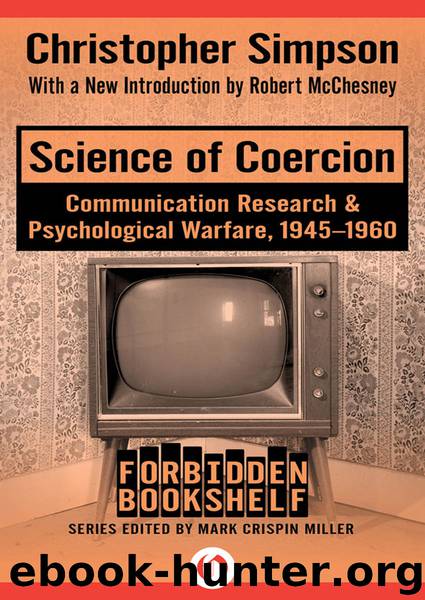Science of Coercion by Christopher Simpson

Author:Christopher Simpson
Language: eng
Format: epub, azw3
ISBN: 9781497672703
Publisher: Open Road Media
8
The Legacy of Psychological Warfare
Wilbur Schramm deserves special mention in any discussion of the evolution of ideas about communication among social scientists in the United States. Schramm’s biographer, Steven Chaffee, has written that Schramm “towers above our field” and that communication studies between 1933 and 1973 might best be described as the “Age of Schramm.” Schramm’s specialty throughout his career was academic administration and the definition and dissemination of the mass communication “knowledge” of his day: Schramm was the “principal disseminator of that zeitgeist [of U.S. mass communication theory], those paradigms and the knowledge yielded by mass communication research,” Chaffee contends.1 James Tankard agrees that “Wilbur Schramm … probably did more to define and establish the field of communication research and theory than any other person.”2 Even when such comments are discounted for hyperbole, it is clear that Schramm was central to U.S. academic programs in mass communication studies between about 1948 and at least 1970.
Schramm’s writings remain important today because of their continuing impact on later generations of scholars and as an illustration of the ideological and political preconceptions of the leadership of the communication education profession during the early cold war years. His writings between 1945 and 1960 reveal a distinctly black and white, Manichaean view of the world that pitted Schramm’s enthusiastic Americanism against ideological rivals abroad and at home.3
Even Schramm’s most vocal advocates concede that his work during his ascendancy to the peak of U.S. journalism education was characterized by “interpreting mass communication behavior in terms almost of ‘good guys’ and ‘bad guys’” and by “a touch of ethnocentrism.”4 Though little remembered today, Schramm prepared his most influential writings, including the watershed text The Process and Effects of Mass Communication, as training materials for U.S. government propaganda programs.5 Similarly, one of Schramm’s most pervasive theoretical contributions, his still widely accepted distinction between “authoritarian” and “Soviet totalitarian” media systems, was developed under USIA contract and based largely on secondary sources concerning the Soviet Union that had themselves been prepared in U.S. psychological warfare programs during the early 1950s.6
There, Schramm contended that authoritarian, anticommunist states should be seen as qualitatively better, more free, and more humane than the Khrushchev-era communist states in Eastern Europe, in part because of the structure of their communication systems. Schramm’s schema lumped quite different societies together into “good” and “bad” categories, ignored the complex relationship between any society’s claims and its actual behavior, and failed to account for elementary aspects of political life in both communist and noncommunist states. What his approach lacked in scientific rigor it more than made up for in political utility, however, for it provided a seemingly rational basis for democracies to underwrite extraordinarily corrupt and brutal governments as a means of facing down the purported totalitarian threat. Schramm’s formulation has passed in and out of fashion in U.S. national security circles. Recently, it was particularly prominent during Jeane Kirkpatrick’s tenure as U.S. ambassador the United Nations.7
Some important Schramm writings from the 1950s concerning communication remain inaccessable today, because
Download
This site does not store any files on its server. We only index and link to content provided by other sites. Please contact the content providers to delete copyright contents if any and email us, we'll remove relevant links or contents immediately.
The Radium Girls by Kate Moore(11616)
100 Deadly Skills by Clint Emerson(4683)
The Templars by Dan Jones(4556)
Rise and Kill First by Ronen Bergman(4542)
The Doomsday Machine by Daniel Ellsberg(4241)
The Rape of Nanking by Iris Chang(4019)
Killing England by Bill O'Reilly(3896)
Hitler in Los Angeles by Steven J. Ross(3796)
Stalin by Stephen Kotkin(3721)
12 Strong by Doug Stanton(3418)
Hitler's Monsters by Eric Kurlander(3161)
Blood and Sand by Alex Von Tunzelmann(3055)
Darkest Hour by Anthony McCarten(3017)
The Code Book by Simon Singh(2854)
The Art of War Visualized by Jessica Hagy(2835)
Hitler's Flying Saucers: A Guide to German Flying Discs of the Second World War by Stevens Henry(2621)
Babylon's Ark by Lawrence Anthony(2427)
The Second World Wars by Victor Davis Hanson(2419)
Tobruk by Peter Fitzsimons(2373)
